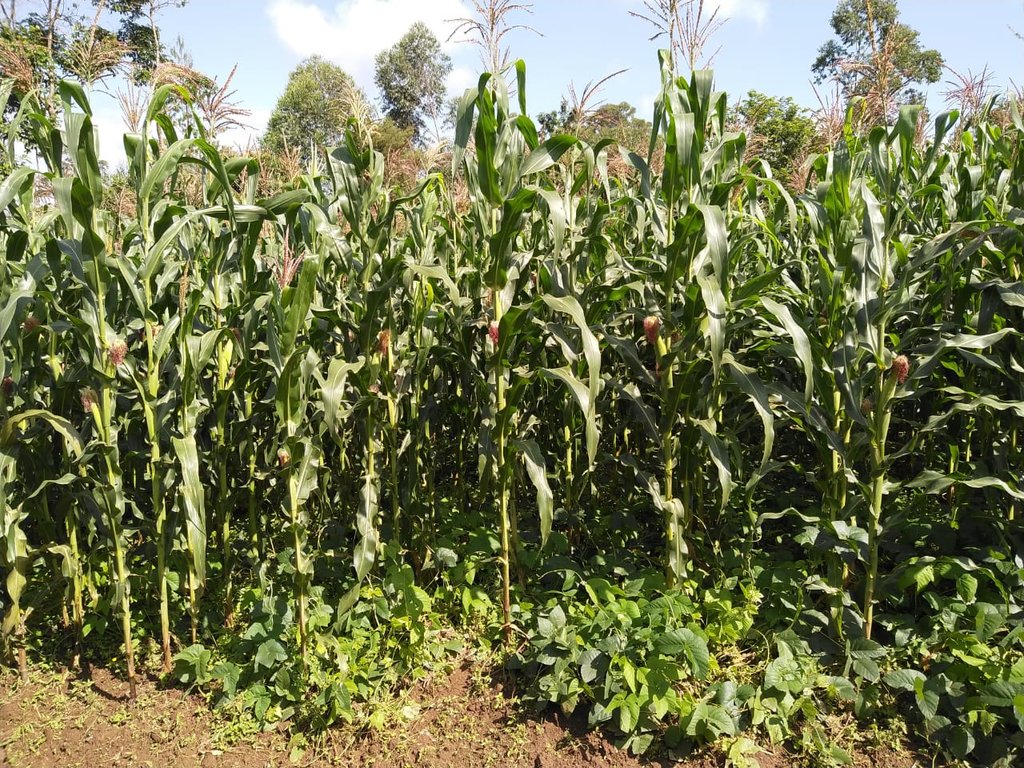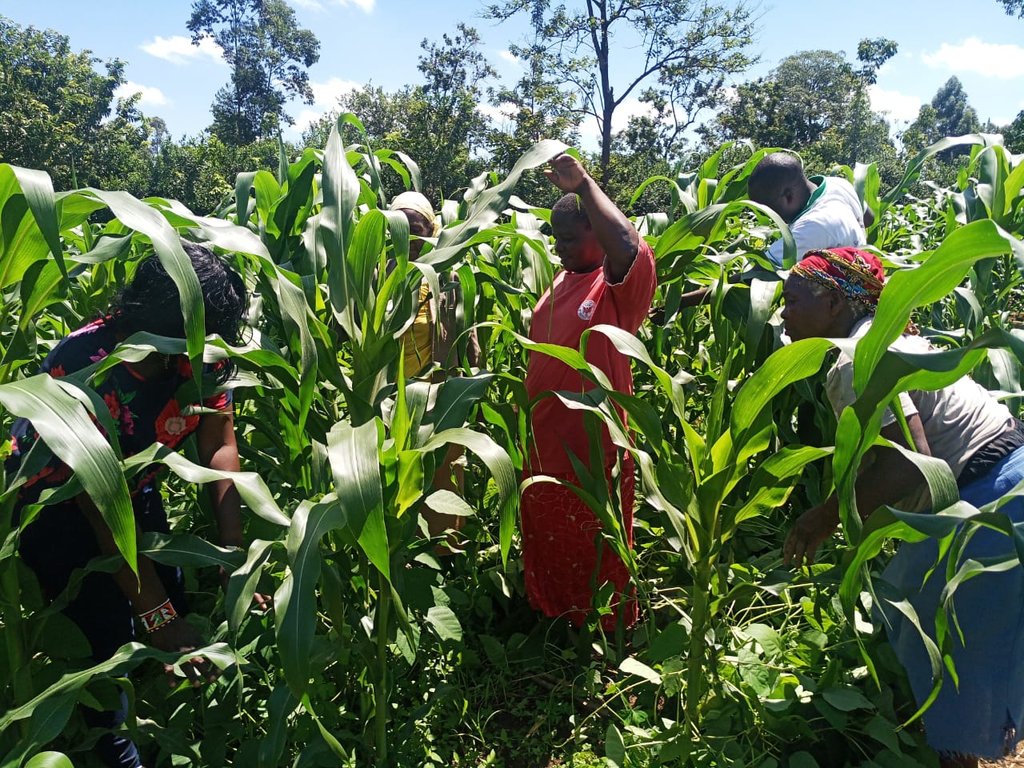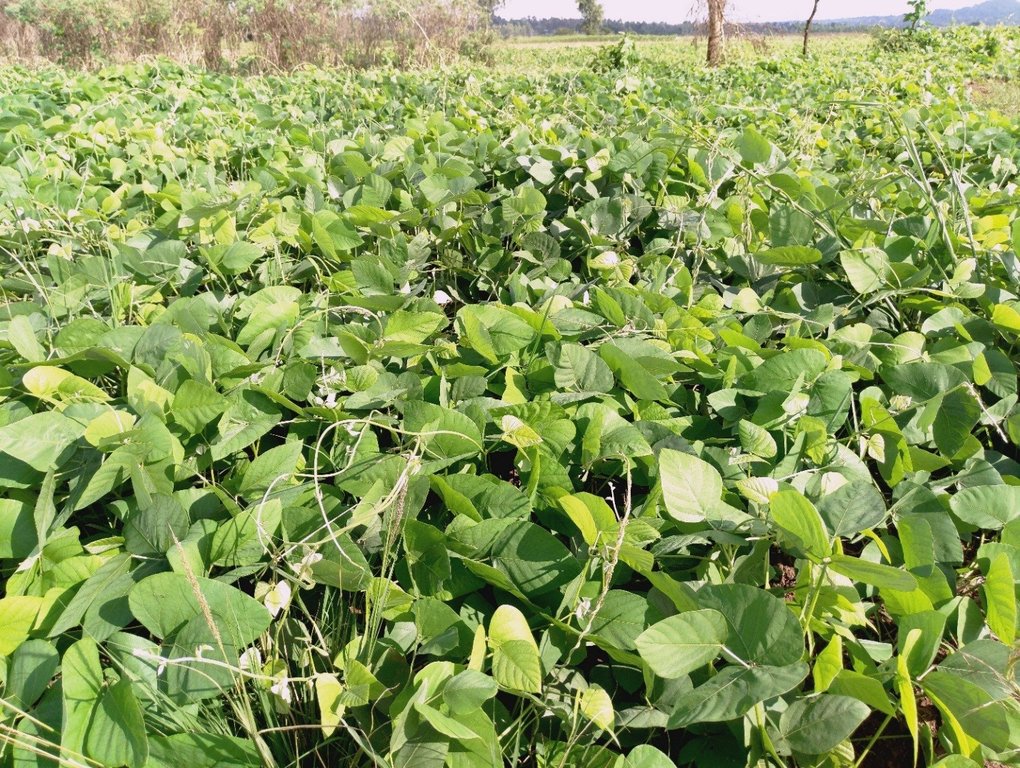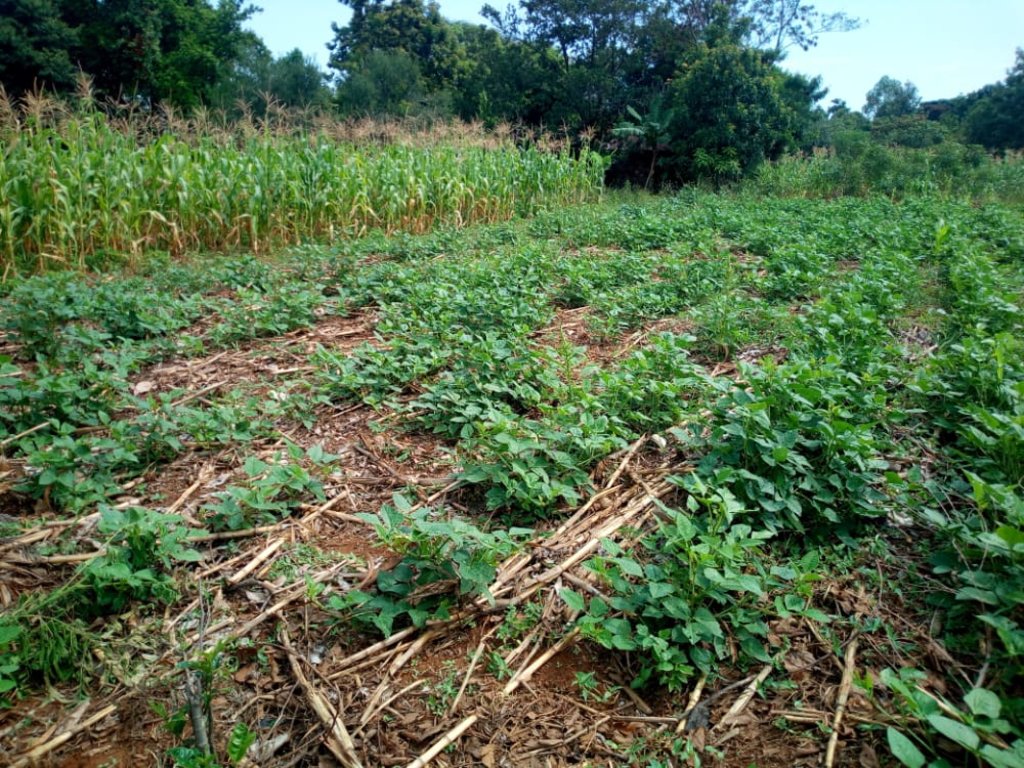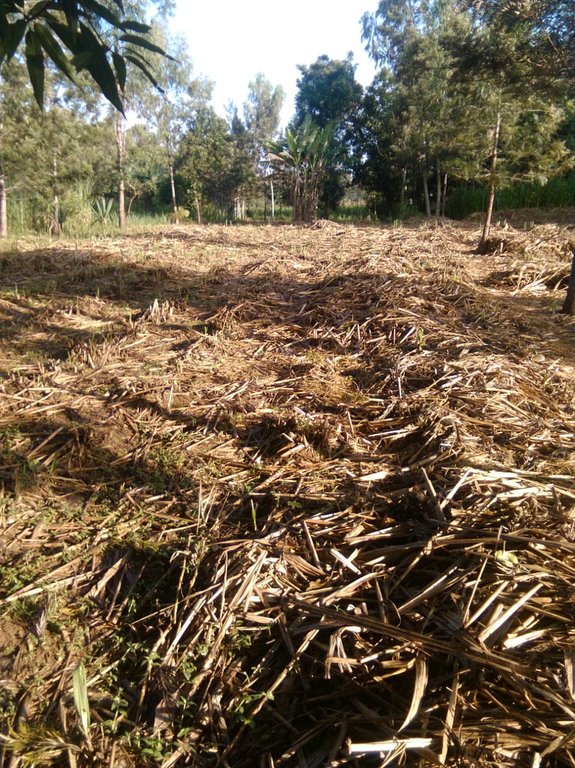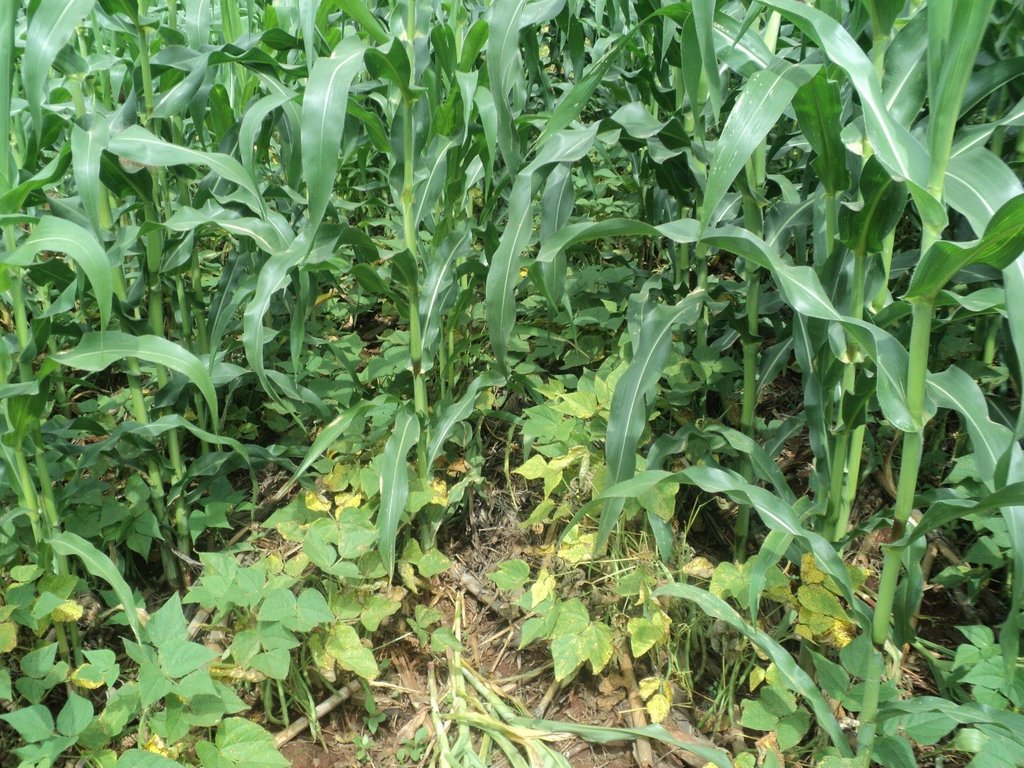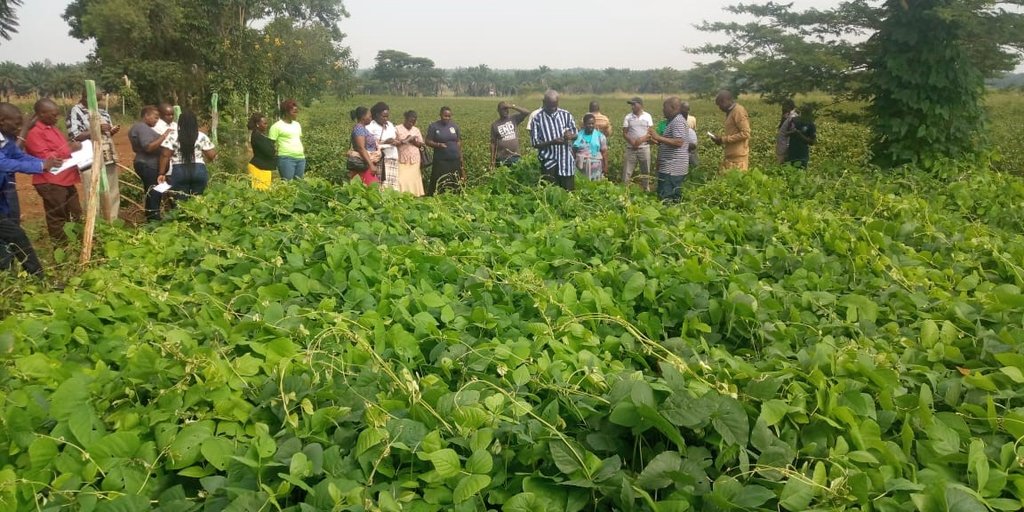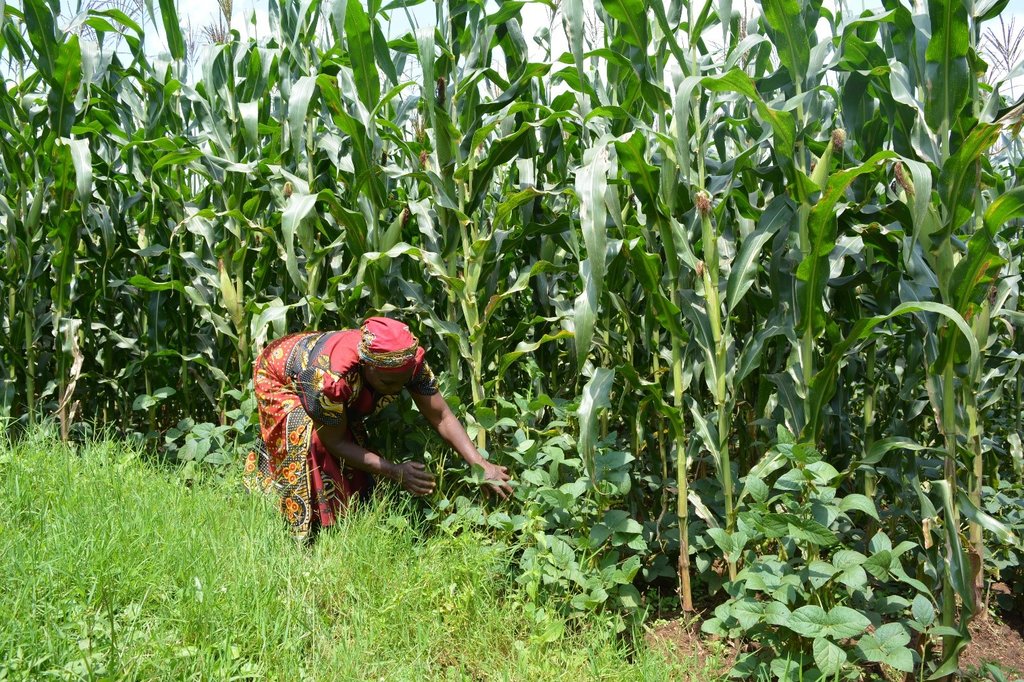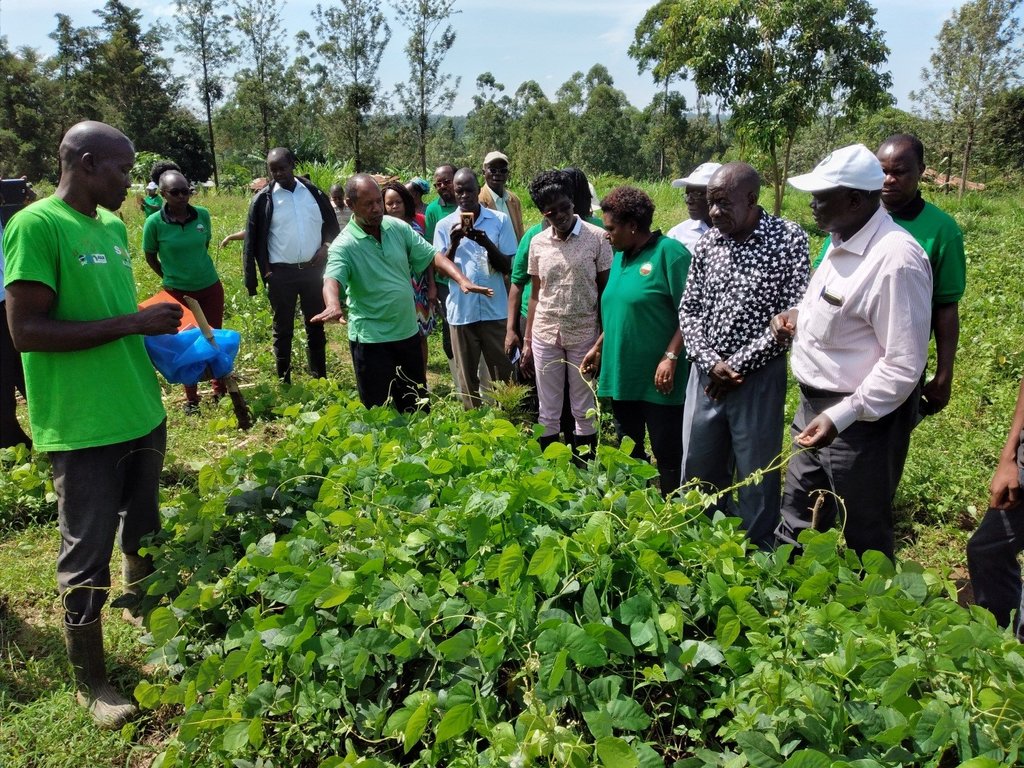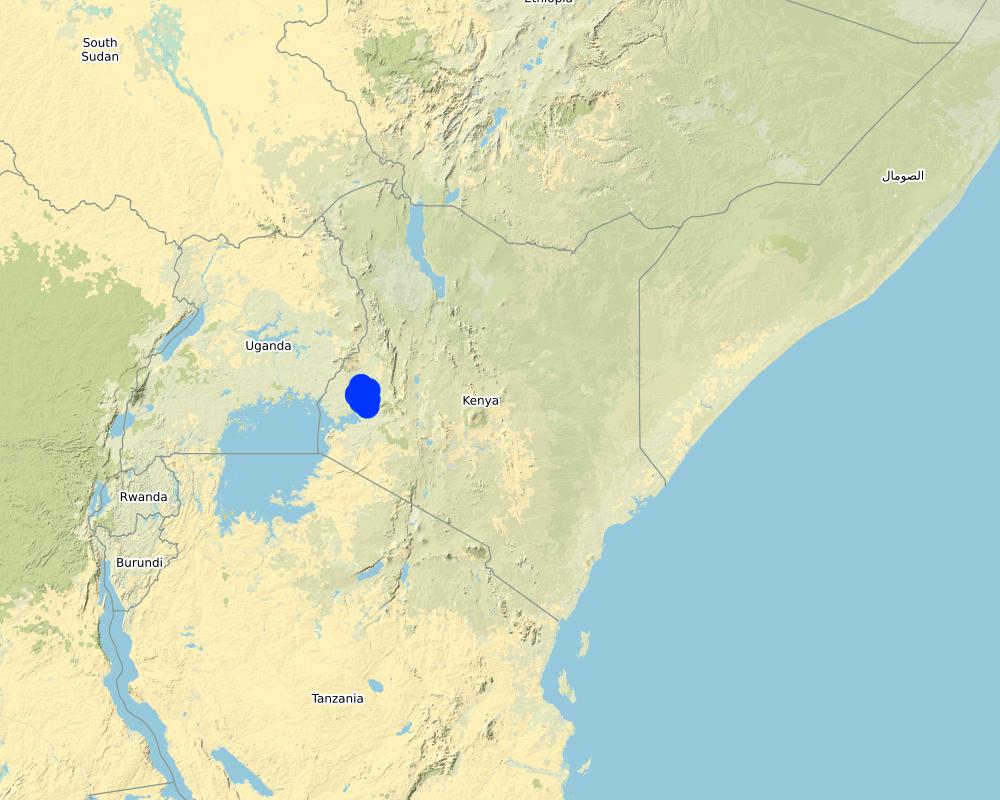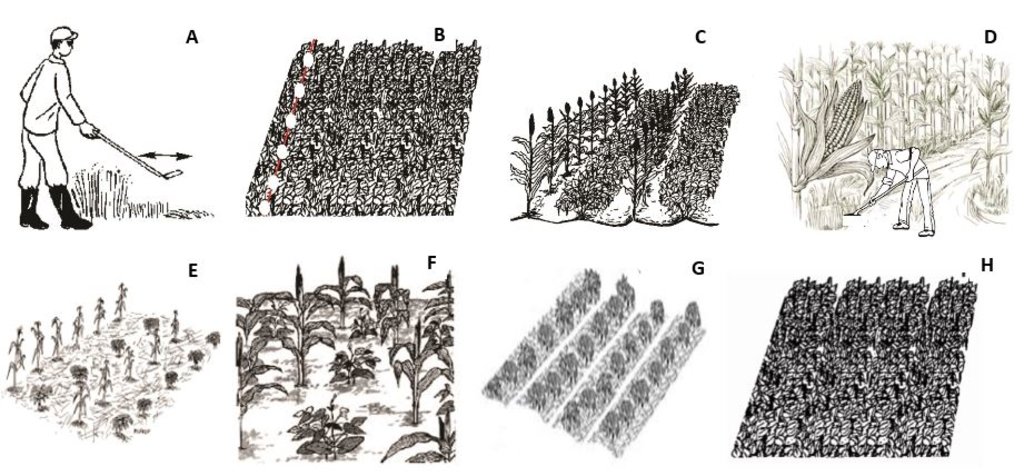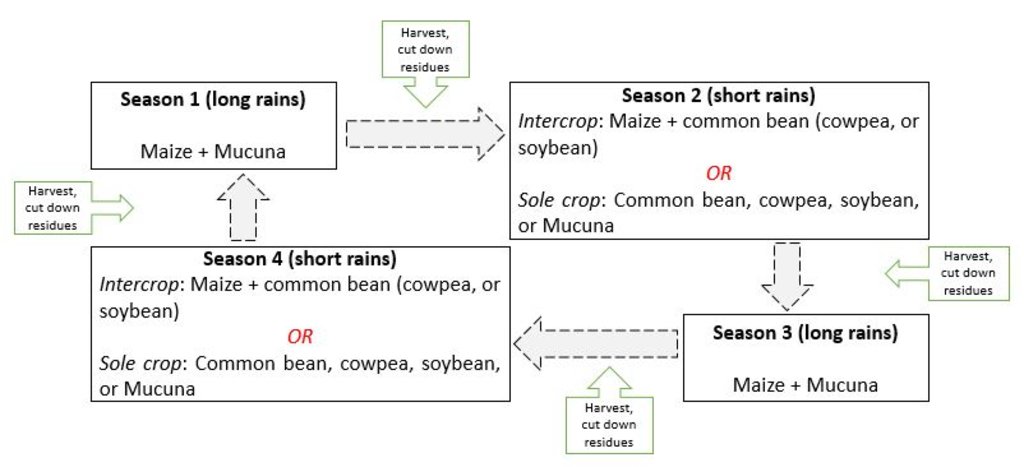Conservation agriculture for maize-legume systems with velvet bean as a dense cover crop [เคนยา]
- ผู้สร้างสรรค์:
- การอัพเดท:
- ผู้รวบรวม: Kennedy Were
- ผู้เรียบเรียง: –
- ผู้ตรวจสอบ: Rima Mekdaschi Studer, Tatenda Lemann
Kilimo hifadhi
technologies_5775 - เคนยา
ดูส่วนย่อย
ขยายทั้งหมด ย่อทั้งหมด1. ข้อมูลทั่วไป
1.2 รายละเอียดที่ติดต่อได้ของผู้รวบรวมและองค์กรที่เกี่ยวข้องในการประเมินและการจัดเตรียมทำเอกสารของเทคโนโลยี
ผู้เชี่ยวชาญ SLM:
ผู้เชี่ยวชาญ SLM:
ผู้เชี่ยวชาญ SLM:
ผู้เชี่ยวชาญ SLM:
ชื่อของโครงการซึ่งอำนวยความสะดวกในการทำเอกสารหรือการประเมินเทคโนโลยี (ถ้าเกี่ยวข้อง)
GEF-UNEP-AGRA-KALRO SLM Projectชื่อของโครงการซึ่งอำนวยความสะดวกในการทำเอกสารหรือการประเมินเทคโนโลยี (ถ้าเกี่ยวข้อง)
Carbon Benefits Project (CBP)ชื่อขององค์กรซึ่งอำนวยความสะดวกในการทำเอกสารหรือการประเมินเทคโนโลยี (ถ้าเกี่ยวข้อง)
Kenya Agricultural and Livestock Research Organization (KALRO) - เคนยา1.3 เงื่อนไขการใช้ข้อมูลที่ได้บันทึกผ่านทาง WOCAT
ผู้รวบรวมและวิทยากรหลักยอมรับเงื่อนไขเกี่ยวกับการใช้ข้อมูลที่ถูกบันทึกผ่านทาง WOCAT:
ใช่
1.4 การเปิดเผยเรื่องความยั่งยืนของเทคโนโลยีที่ได้อธิบายไว้
เทคโนโลยีที่ได้อธิบายไว้นี้เป็นปัญหาของความเสื่อมโทรมโทรมของที่ดินหรือไม่ จึงไม่ได้รับการยอมรับว่าเป็นเทคโนโลยีเพื่อการจัดการที่ดินอย่างยั่งยืน:
ไม่ใช่
2. การอธิบายลักษณะของเทคโนโลยี SLM
2.1 การอธิบายแบบสั้น ๆ ของเทคโนโลยี
คำจำกัดความของเทคโนโลยี:
Conservation agriculture for maize-legume systems with velvet bean (Mucuna pruriens) as a dense cover crop is being promoted in western Kenya to address the challenges of land degradation, low crop yields, low incomes, high production costs and climate change.
2.2 การอธิบายแบบละเอียดของเทคโนโลยี
คำอธิบาย:
Agriculture in western Kenya suffers from low productivity due to the degraded landscape. The soils are predominantly acidic and low in fertility, with the yields of food staples, such as maize and common bean averaging 1 ton/ ha and 5 tons/ ha, respectively. Consequently, the smallholder farmers have encroached into the adjacent Kakamega and Nandi forests in their quest for supplementary agro-ecosystem services and farm incomes. Degradation of the agro-resource base is underpinned by unsustainable practices carried out under conventional farming; for example, continuous cultivation with low nutrient inputs, mono-cropping, removal of crop residues and full tillage. Some of these practices enhance climate change by intensifying the emissions of greenhouse gases, such as carbon dioxide (CO2) into the atmosphere. Therefore, widespread adoption of conservation agriculture (CA) technology is being promoted to reduce the adverse impacts of conventional farming and enhance sustainable land management, environmental protection, and climate change mitigation and adaptation in 10 micro-catchments located within a 5-km radius from the edge of Kakamega and Nandi forests. The CA technology is characterized by the principles of minimum mechanical soil disturbance, maintenance of at least 30 percent permanent organic soil cover, diversified cropping through intercropping and crop rotations, and weed control. These principles have been adapted to the local conditions and needs.
The establishment of CA technology begins with land preparation. That is, the existing weeds and previous crop residues in the field are either slashed, or controlled through the application of appropriate herbicides. All the residues are retained on soil surface as opposed to burning, or removal in the conventional system. Land preparation is followed by planting, where the jab planter is used for precise placement of seeds and fertilizers in un-ploughed field, or within the established planting hills and rip lines to minimize soil tillage. This contrasts with conventional farming practice where a plough, or a hand hoe is used to till the entire field and establish the planting holes for placing seeds and fertilizers. A combination of cereal (maize – Zea mays L.) and legumes (common bean – Phaseolus vulgaris L., soybean - Glycine max, velvet bean – Mucuna pruriens and cowpea – Vigna unguiculata) are either intercropped, or rotated in the field each season to optimize the use of the available soil resources, including water, nutrients, and micro-organisms. The main cereal-legume association involves the establishment of Mucuna pruriens under maize as a dense cover crop. In this cropping system, Mucuna pruriens seeds are sown within a spacing of 1 m × 0.5 m where they grow and spread to completely cover the soil surface. As the cover crop grows, the leaves fall and decompose on the ground, enriching the soil’s nutrients, organic matter and fertility. The maize - Mucuna pruriens mix is rotated with either sole common bean, soybean and cowpea crop, or an intercrop of maize with any of the legumes. Weeding is carried out using either selective herbicides, or weed scrapers. When designing the intercropping and rotation plans, crop families (N-fixing vs. non-fixing), root depths (shallow vs. deep roots), and susceptibility to diseases, pests and weeds are all considered.
Generally, CA technologies have multiple benefits for farmers and the environment. In the context of the Kakamega-Nandi forest landscape, the CA plots with Mucuna pruriens as a dense cover crop have shown improved soil organic matter, soil structure and nutrient status. It is expected that this will reduce the use of fertilizers over time. Most farmers have also reported that reduced tillage and direct placement of inputs (seeds and fertilizers) save them time, money, fuel, labour and inputs. Aside from saving resources, reduced tillage will ultimately enhance soil living organisms and mitigate atmospheric CO2 emissions through the decrease in fuel consumption and soil disturbance. Moreover, farmers have observed that the maize established with Mucuna pruriens as a cover crop remains green and healthy for long during mid-season dry spells compared to those under mono-culture, or light mulch. This implies that the CA technology also increases water infiltration and soil water content; thus, acting as insurance against drought. The increase in water infiltration and soil moisture occurs because the dense Mucuna pruriens cover crop not only regulates the soil surface temperatures and evaporation, but also reduces surface runoff and exposure to wind erosion. In addition, farmers have witnessed the suppression of weeds, such as Striga hermonthica (witchweed) in plots under dense cover crop and diversified cropping. Besides, diversified cropping through rotations has reduced the incidences of insect pests and diseases, as well as the risk of crop failure during extreme weather conditions and pest infestations. Specifically, farmers have noticed that the CA plots under maize - Mucuna pruriens intercrop are less affected by the fall armyworm (Spodoptera frugiperda) compared to those under mono-culture. They have also noted that, in seasons of excessive rainfall, the maize intercropped with the common bean is usually harvested even when the common bean fails. Most importantly, these CA benefits have boosted maize yields by over 50 percent, meaning more food and income, and fewer forest encroachments.
Proper adoption of the CA technology by land users within the Kakamega-Nandi forest landscape is being hampered by several factors. Firstly, crop residues are inadequate due to competing uses, such as animal feed and fuel. At times, livestock is even allowed to graze on the stubble field, contravening the CA principles. Besides, some farmers have not fully embraced crop diversification and still grow maize throughout the seasons without rotation with other drought-tolerant cereals, such as sorghum and millet. Conventional ploughing is also quite entrenched. Further, some farmers still do not prefer Mucuna pruriens as a cover crop because of insufficient knowledge on the utilization of its inedible yields. Lastly, some farmers are finding it hard to access CA inputs and tools, such as the jab planters, weed scrapers, herbicides and seeds of Mucuna pruriens owing to either high prices, or shortages.
2.3 รูปภาพของเทคโนโลยี
2.4 วีดีโอของเทคโนโลยี
2.5 ประเทศภูมิภาค หรือสถานที่ตั้งที่เทคโนโลยีได้นำไปใช้และได้รับการครอบคลุมโดยการประเมินนี้
ประเทศ:
เคนยา
ภูมิภาค/รัฐ/จังหวัด:
Western region
ข้อมูลจำเพาะเพิ่มเติมของสถานที่ตั้ง :
Kakamega-Nandi forest landscape
ระบุการกระจายตัวของเทคโนโลยี:
- ใช้ ณ จุดที่เฉพาะเจาะจงหรือเน้นไปยังบริเวณพื้นที่ขนาดเล็ก
Is/are the technology site(s) located in a permanently protected area?
ไม่ใช่
Map
×2.6 วันที่การดำเนินการ
ระบุปีที่ใช้:
2019
2.7 คำแนะนำของเทคโนโลยี
ให้ระบุว่าเทคโนโลยีถูกแนะนำเข้ามาอย่างไร:
- ในช่วงการทดลองหรือการทำวิจัย
- ทางโครงการหรือจากภายนอก
ความคิดเห็น (ประเภทของโครงการ เป็นต้น) :
Projects and research focusing mainly on advancing land degradation neutrality and agricultural productivity in the area
3. การจัดประเภทของเทคโนโลยี SLM
3.1 วัตถุประสงค์หลักของเทคโนโลยี
- ปรับปรุงการผลิตให้ดีขึ้น
- ลด ป้องกัน ฟื้นฟู การเสื่อมโทรมของที่ดิน
- รักษาสภาพหรือปรับปรุงความหลากหลายทางชีวภาพ
- ชะลอการเปลี่ยนแปลงภูมิอากาศของโลกและผลกระทบ
- สร้างผลกระทบทางด้านเศรษฐกิจที่เป็นประโยชน์
3.2 ประเภทของการใช้ที่ดินในปัจจุบันที่ได้นำเทคโนโลยีไปใช้
Land use mixed within the same land unit:
ใช่
Specify mixed land use (crops/ grazing/ trees):
- Agro-pastoralism (incl. integrated crop-livestock)

พื้นที่ปลูกพืช
- การปลูกพืชล้มลุกอายุปีเดียว
Annual cropping - Specify crops:
- cereals - maize
- legumes and pulses - beans
- legumes and pulses - peas
- legumes and pulses - soya
Annual cropping system:
Maize/sorghum/millet intercropped with legume
จำนวนของฤดูเพาะปลูกต่อปี:
- 2
ระบุ:
Long rain season (March to May) and short rain season (October to December)
Is intercropping practiced?
ใช่
If yes, specify which crops are intercropped:
Maize and legumes (i.e., common bean, soybean and velvet bean – Mucuna pruriens)
Is crop rotation practiced?
ใช่
ถ้าใช่ ระบุ:
Maize and legumes (i.e., common bean, soybean and velvet bean – Mucuna pruriens)

ทุ่งหญ้าเลี้ยงสัตว์
ทุ่งหญ้าเลี้ยงสัตว์ที่มีการจัดการแบบเข้มข้นหรือการผลิตอาหารสัตว์:
- ตัดแล้วขนไป / ไม่มีการปล่อยแทะเล็มเอง (Cut-and-carry / zero grazing)
- ทุ่งหญ้าเลี้ยงสัตว์ที่ได้มีการปรับปรุง (Improved pastures)
Animal type:
- cattle - dairy and beef (e.g. zebu)
Is integrated crop-livestock management practiced?
ใช่
ถ้าใช่ ระบุ:
Manure is used for fertilization and crop residues are used as cattle feed
ผลิตภัณฑ์และบริการ:
- manure as fertilizer/ energy production
- meat
- milk
- skins/ hides
- transport/ draught
3.3 Has land use changed due to the implementation of the Technology?
Has land use changed due to the implementation of the Technology?
- Yes (Please fill out the questions below with regard to the land use before implementation of the Technology)
Land use mixed within the same land unit:
ใช่
Specify mixed land use (crops/ grazing/ trees):
- Agro-pastoralism (incl. integrated crop-livestock)

พื้นที่ปลูกพืช
- การปลูกพืชล้มลุกอายุปีเดียว
Annual cropping - Specify crops:
- cereals - maize
Annual cropping system:
Continuous maize/sorghum/millet
Is intercropping practiced?
ไม่ใช่
Is crop rotation practiced?
ไม่ใช่

ทุ่งหญ้าเลี้ยงสัตว์
ทุ่งหญ้าเลี้ยงสัตว์ที่มีการจัดการแบบเข้มข้นหรือการผลิตอาหารสัตว์:
- ตัดแล้วขนไป / ไม่มีการปล่อยแทะเล็มเอง (Cut-and-carry / zero grazing)
Animal type:
- cattle - dairy and beef (e.g. zebu)
Is integrated crop-livestock management practiced?
ใช่
ถ้าใช่ ระบุ:
Manure is used for fertilization and crop residues are used as cattle feed
ผลิตภัณฑ์และบริการ:
- manure as fertilizer/ energy production
- meat
- milk
- skins/ hides
- transport/ draught
3.4 การใช้น้ำ
การใช้น้ำของที่ดินที่มีการใช้เทคโนโลยีอยู่:
- จากน้ำฝน
3.5 กลุ่ม SLM ที่ตรงกับเทคโนโลยีนี้
- การปรับปรุงดิน / พืชคลุมดิน
- การรบกวนดินให้น้อยที่สุด
- การจัดการความอุดมสมบรูณ์ของดินแบบผสมผสาน
3.6 มาตรการ SLM ที่ประกอบกันเป็นเทคโนโลยี

มาตรการจัดการพืช
- A1: พืช/สิ่งปกคลุมดิน
- A2: อินทรียวัตถุในดิน/ความอุดมสมบูรณ์ในดิน
- A3: การรักษาหน้าดิน
- A6: Residue management
A3: Differentiate tillage systems:
A 3.2: Reduced tillage (> 30% soil cover)
A6: Specify residue management:
A 6.4: retained
3.7 รูปแบบหลักของการเสื่อมโทรมของที่ดินที่ได้รับการแก้ไขโดยเทคโนโลยี

การกัดกร่อนของดินโดยน้ำ
- Wt (Loss of topsoil): การสูญเสียดินชั้นบนหรือการกัดกร่อนที่ผิวดิน

การกัดกร่อนของดินโดยลม
- Et (Loss of topsoil): การสูญเสียดินชั้นบน

การเสื่อมโทรมของดินทางด้านเคมี
- Cn (Fertility decline): ความอุดมสมบูรณ์และปริมาณอินทรียวัตถุในดินถูกทำให้ลดลงไป (ไม่ได้เกิดจากสาเหตุการกัดกร่อน)

การเสื่อมโทรมของดินทางด้านกายภาพ
- Pc (Compaction): การอัดแน่น

การเสื่อมโทรมของดินทางด้านชีวภาพ
- Bl (Loss of soil life): การสูญเสียสิ่งมีชีวิตในดิน

การเสื่อมโทรมของน้ำ
- Ha (Aridification): การเกิดความแห้งแล้ง
3.8 การป้องกัน การลดลง หรือการฟื้นฟูความเสื่อมโทรมของที่ดิน
ระบุเป้าหมายของเทคโนโลยีกับความเสื่อมโทรมของที่ดิน:
- ลดความเสื่อมโทรมของดิน
4. ข้อมูลจำเพาะด้านเทคนิค กิจกรรมการนำไปปฏิบัติใช้ ปัจจัยนำเข้า และค่าใช้จ่าย
4.1 แบบแปลนทางเทคนิคของเทคโนโลยี
ข้อมูลจำเพาะด้านเทคนิค (แบบแปลนทางเทคนิคของเทคโนโลยี):
The first technical drawing shows a typical farm under CA with various principles:
A - Clearance of weeds and previous crop residues through slashing in preparation for planting in season 1 (long rains). The residues are retained on the plot.
B - In a plot under total soil cover with Mucuna pruriens, maize seed and fertilizer are placed at the precise planting hills, denoted by the white circles along the red line, using a jab planter to minimize soil tillage.
C - Maize crop establishes under the dense cover of Mucuna pruriens.
D - Weeding of the maize crop is done using a weed scraper.
E & F - In season 2 (short rains), after harvesting maize in the previous maize – Mucuna cropping system and cutting down the residues, either a row intercropping system with alternate rows of maize and soybean (E), or maize and common bean (F) under maize straw mulch is established.
G & H - Alternatively, in season 2 (short rains), either sole common bean (cowpea, or soybean) production under maize straw mulch (G), or total soil cover with Mucuna pruriens (H) is established in the plot.
ผู้เขียน:
Sam Koile, Kennedy Were & George Ayaga
วันที่:
31/05/2020
ข้อมูลจำเพาะด้านเทคนิค (แบบแปลนทางเทคนิคของเทคโนโลยี):
The second technical drawing is an illustration of a four season (2-year) rotation of maize, legumes and cover crop
ผู้เขียน:
Kennedy Were, Sam Koile & George Ayaga
วันที่:
15/07/2020
4.2 ข้อมูลทั่วไปเกี่ยวกับการคำนวณปัจจัยนำเข้าและค่าใช้จ่าย
ให้ระบุว่าค่าใช้จ่ายและปัจจัยนำเข้าได้รับการคำนวณอย่างไร:
- ต่อพื้นที่ที่ใช้เทคโนโลยี
ระบุขนาดและหน่วยพื้นที่:
1 ha
If using a local area unit, indicate conversion factor to one hectare (e.g. 1 ha = 2.47 acres): 1 ha =:
2.47 acres
อื่นๆ หรือสกุลเงินประจำชาติ (ระบุ):
KES
If relevant, indicate exchange rate from USD to local currency (e.g. 1 USD = 79.9 Brazilian Real): 1 USD =:
107.08
ระบุค่าเฉลี่ยของค่าจ้างในการจ้างแรงงานต่อวัน:
300
4.3 กิจกรรมเพื่อการจัดตั้ง
| กิจกรรม | Timing (season) | |
|---|---|---|
| 1. | Purchase of CA tools - jab planter, knapsack sprayer, protection gear, slasher, weed scraper, and gunny bag) | Initial stage |
4.4 ค่าใช้จ่ายของปัจจัยนำเข้าที่จำเป็นสำหรับการจัดตั้ง
| ปัจจัยนำเข้า | หน่วย | ปริมาณ | ค่าใช้จ่ายต่อหน่วย | ค่าใช้จ่ายทั้งหมดต่อปัจจัยนำเข้า | %ของค่าใช้จ่ายที่ก่อให้เกิดขึ้นโดยผู้ใช้ที่ดิน | |
|---|---|---|---|---|---|---|
| อุปกรณ์ | Jab planter | Piece | 2.0 | 1500.0 | 3000.0 | 100.0 |
| อุปกรณ์ | Knapsack sprayer | Piece | 2.0 | 2500.0 | 5000.0 | 100.0 |
| อุปกรณ์ | Protection gear | Piece | 2.0 | 1000.0 | 2000.0 | 100.0 |
| อุปกรณ์ | Weed scraper | Piece | 2.0 | 500.0 | 1000.0 | 100.0 |
| อุปกรณ์ | Slasher | Piece | 2.0 | 500.0 | 1000.0 | 100.0 |
| อุปกรณ์ | Gunny bag | Piece | 50.0 | 50.0 | 2500.0 | 100.0 |
| ค่าใช้จ่ายทั้งหมดของการจัดตั้งเทคโนโลยี | 14500.0 | |||||
| Total costs for establishment of the Technology in USD | 135.41 | |||||
4.5 การบำรุงรักษาสภาพหรือกิจกรรมที่เกิดขึ้นเป็นประจำ
| กิจกรรม | ช่วงระยะเวลา/ความถี่ | |
|---|---|---|
| 1. | Land preparation - Slashing | Initial stage |
| 2. | Preparing the planting hills and rip lines | Initial stage |
| 3. | Planting - placing seeds and fertilizer using jab planter | Initial stage |
| 4. | Herbicide application | Initial and growing stages |
| 5. | Pesticide application | Growing stage |
| 6. | Fertilizer application (top-dressing) | Growing stage |
| 7. | Harvesting, drying and shelling | Final stage |
4.6 ค่าใช้จ่ายของปัจจัยนำเข้าและกิจกรรมที่เกิดขึ้นเป็นประจำที่ต้องการการบำรุงรักษา (ต่อปี)
| ปัจจัยนำเข้า | หน่วย | ปริมาณ | ค่าใช้จ่ายต่อหน่วย | ค่าใช้จ่ายทั้งหมดต่อปัจจัยนำเข้า | %ของค่าใช้จ่ายที่ก่อให้เกิดขึ้นโดยผู้ใช้ที่ดิน | |
|---|---|---|---|---|---|---|
| แรงงาน | Land preparation - slashing and herbicide application | Man day | 4.0 | 300.0 | 1200.0 | 100.0 |
| แรงงาน | Planting - preparing the planting hills and placing seeds and fertilizer | Man day | 38.0 | 300.0 | 11400.0 | 100.0 |
| แรงงาน | Top-dressing and pesticide application | Man day | 8.0 | 300.0 | 2400.0 | 100.0 |
| แรงงาน | Harvesting, shelling and drying | Man day | 30.0 | 300.0 | 9000.0 | 100.0 |
| วัสดุด้านพืช | Maize seed | Kg | 20.0 | 250.0 | 5000.0 | 100.0 |
| วัสดุด้านพืช | Legume seed | Kg | 8.0 | 250.0 | 2000.0 | 100.0 |
| ปุ๋ยและสารฆ่า/ยับยั้งการเจริญเติบโตของสิ่งมีชีวิต (ไบโอไซด์) | Planting fertilizer | Kg | 125.0 | 60.0 | 7500.0 | 100.0 |
| ปุ๋ยและสารฆ่า/ยับยั้งการเจริญเติบโตของสิ่งมีชีวิต (ไบโอไซด์) | Top-dressing fertilizer | Kg | 125.0 | 50.0 | 6250.0 | 100.0 |
| ปุ๋ยและสารฆ่า/ยับยั้งการเจริญเติบโตของสิ่งมีชีวิต (ไบโอไซด์) | Pesticide | Litre | 2.0 | 1250.0 | 2500.0 | 100.0 |
| ปุ๋ยและสารฆ่า/ยับยั้งการเจริญเติบโตของสิ่งมีชีวิต (ไบโอไซด์) | Herbicide | Litre | 5.0 | 875.0 | 4375.0 | 100.0 |
| อื่น ๆ | Transport | Km | 5.0 | 1500.0 | 7500.0 | 100.0 |
| ค่าใช้จ่ายทั้งหมดของการบำรุงรักษาสภาพเทคโนโลยี | 59125.0 | |||||
| Total costs for maintenance of the Technology in USD | 552.16 | |||||
4.7 ปัจจัยสำคัญที่สุดที่มีผลกระทบต่อค่าใช้จ่าย
ปัจจัยสำคัญที่สุดที่มีผลกระทบต่อค่าใช้จ่ายต่างๆ:
1. Prevailing market prices of the inputs, equipment and labour.
5. สิ่งแวดล้อมทางธรรมชาติและของมนุษย์
5.1 ภูมิอากาศ
ฝนประจำปี
- < 250 ม.ม.
- 251-500 ม.ม.
- 501-750 ม.ม.
- 751-1,000 ม.ม.
- 1,001-1,500 ม.ม.
- 1,501-2,000 ม.ม.
- 2,001-3,000 ม.ม.
- 3,001-4,000 ม.ม.
- > 4,000 ม.ม.
ข้อมูลจำเพาะ/ความคิดเห็นเรื่องปริมาณน้ำฝน:
Rainfall is bi-modal with the long rain season starting from March to May, and the short rains from October to December.
เขตภูมิอากาศเกษตร
- ชื้น
- กึ่งชุ่มชื้น
mean annual temperature varies from 18 to 29° C
5.2 สภาพภูมิประเทศ
ค่าเฉลี่ยความลาดชัน:
- ราบเรียบ (0-2%)
- ลาดที่ไม่ชัน (3-5%)
- ปานกลาง (6-10%)
- เป็นลูกคลื่น (11-15%)
- เป็นเนิน (16-30%)
- ชัน (31-60%)
- ชันมาก (>60%)
ธรณีสัณฐาน:
- ที่ราบสูง/ที่ราบ
- สันเขา
- ไหล่เขา
- ไหล่เนินเขา
- ตีนเนิน
- หุบเขา
ระดับความสูง:
- 0-100 เมตร
- 101-500 เมตร
- 501-1,000 เมตร
- 1,001-1,500 เมตร
- 1,501-2,000 เมตร
- 2,001-2,500 เมตร
- 2,501-3,000 เมตร
- 3,001-4,000 เมตร
- > 4,000 เมตร
ให้ระบุถ้าเทคโนโลยีได้ถูกนำไปใช้:
- ไม่เกี่ยวข้อง
5.3 ดิน
ค่าเฉลี่ยความลึกของดิน:
- ตื้นมาก (0-20 ซ.ม.)
- ตื้น (21-50 ซ.ม.)
- ลึกปานกลาง (51-80 ซ.ม.)
- ลึก (81-120 ซ.ม.)
- ลึกมาก (>120 ซ.ม.)
เนื้อดิน (ดินชั้นบน):
- ปานกลาง (ดินร่วน ทรายแป้ง)
- ละเอียด/หนัก (ดินเหนียว)
เนื้อดินล่าง (> 20 ซ.ม.ต่ำจากผิวดิน):
- ปานกลาง (ดินร่วน ทรายแป้ง)
- ละเอียด/หนัก (ดินเหนียว)
อินทรียวัตถุในดิน:
- ปานกลาง (1-3%)
- ต่ำ (<1%)
5.4 ความเป็นประโยชน์และคุณภาพของน้ำ
ระดับน้ำใต้ดิน:
5-50 เมตร
น้ำไหลบ่าที่ผิวดิน:
ปานกลาง
คุณภาพน้ำ (ที่ยังไม่ได้บำบัด):
เป็นน้ำเพื่อการดื่มที่ไม่ดี (จำเป็นต้องได้รับการบำบัด)
Water quality refers to:
both ground and surface water
ความเค็มของน้ำเป็นปัญหาหรือไม่:
ไม่ใช่
กำลังเกิดน้ำท่วมในพื้นที่หรือไม่:
ไม่ใช่
5.5 ความหลากหลายทางชีวภาพ
ความหลากหลายทางชนิดพันธุ์:
- ปานกลาง
ความหลากหลายของแหล่งที่อยู่:
- ปานกลาง
5.6 ลักษณะของผู้ใช้ที่ดินที่นำเทคโนโลยีไปปฏิบัติใช้
อยู่กับที่หรือเร่ร่อน:
- อยู่กับที่
แนวทางการตลาดของระบบการผลิต:
- เพื่อการยังชีพ (หาเลี้ยงตนเอง)
- mixed (subsistence/ commercial)
รายได้ที่มาจากนอกฟาร์ม:
- < 10% ของรายได้ทั้งหมด
- 10-50% ของรายได้ทั้งหมด
ระดับของความมั่งคั่งโดยเปรียบเทียบ:
- จน
- พอมีพอกิน
เป็นรายบุคคล/ครัวเรือน:
- เป็นรายบุคคล/ครัวเรือน
ระดับของการใช้เครื่องจักรกล:
- งานที่ใช้แรงกาย
- การใช้กำลังจากสัตว์
เพศ:
- หญิง
- ชาย
อายุของผู้ใช้ที่ดิน:
- วัยกลางคน
- ผู้สูงอายุ
5.7 Average area of land used by land users applying the Technology
- < 0.5 เฮกตาร์
- 0.5-1 เฮกตาร์
- 1-2 เฮกตาร์
- 2-5 เฮกตาร์
- 5-15 เฮกตาร์
- 15-50 เฮกตาร์
- 50-100 เฮกตาร์
- 100-500 เฮกตาร์
- 500-1,000 เฮกตาร์
- 1,000-10,000 เฮกตาร์
- >10,000 เฮกตาร์
พิจารณาว่าเป็นขนาดเล็ก กลาง หรือขนาดใหญ่ (ซึ่งอ้างอิงถึงบริบทระดับท้องถิ่น):
- ขนาดเล็ก
5.8 กรรมสิทธิ์ในที่ดิน สิทธิในการใช้ที่ดินและสิทธิในการใช้น้ำ
กรรมสิทธิ์ในที่ดิน:
- รายบุคคล ไม่ได้รับสิทธิครอบครอง
- รายบุคคล ได้รับสิทธิครอบครอง
สิทธิในการใช้ที่ดิน:
- รายบุคคล
สิทธิในการใช้น้ำ:
- เกี่ยวกับชุมชน (ถูกจัดระเบียบ)
- รายบุคคล
Are land use rights based on a traditional legal system?
ใช่
5.9 การเข้าถึงบริการและโครงสร้างพื้นฐาน
สุขภาพ:
- จน
- ปานกลาง
- ดี
การศึกษา:
- จน
- ปานกลาง
- ดี
ความช่วยเหลือทางด้านเทคนิค:
- จน
- ปานกลาง
- ดี
การจ้างงาน (เช่น ภายนอกฟาร์ม):
- จน
- ปานกลาง
- ดี
ตลาด:
- จน
- ปานกลาง
- ดี
พลังงาน:
- จน
- ปานกลาง
- ดี
ถนนและการขนส่ง:
- จน
- ปานกลาง
- ดี
น้ำดื่มและการสุขาภิบาล:
- จน
- ปานกลาง
- ดี
บริการด้านการเงิน:
- จน
- ปานกลาง
- ดี
6. ผลกระทบและสรุปคำบอกกล่าว
6.1 ผลกระทบในพื้นที่ดำเนินการ (On-site) จากการใช้เทคโนโลยี
ผลกระทบทางด้านเศรษฐกิจและสังคม
การผลิต
การผลิตพืชผล
จำนวนก่อน SLM:
24 bags/ ha
หลังจาก SLM:
43 bags/ ha
แสดงความคิดเห็น/ระบุ:
This can be attributed to the multiple benefits of the CA technology, such as improved soil organic matter content and nutrient status. Note: A standard bag weighs 90 kgs.
คุณภาพพืชผล
แสดงความคิดเห็น/ระบุ:
The multiple benefits of the CA technology, such as improved soil conditions and alleviation of pests and diseases, not only increased crop production (yields), but also the quality of the crops.
การผลิตพืชที่ใช้เลี้ยงปศุสัตว์
แสดงความคิดเห็น/ระบุ:
Increased crop production also means increased fodder production because the crop residues are partly used as animal feed
คุณภาพพืชที่ใช้เลี้ยงปศุสัตว์
แสดงความคิดเห็น/ระบุ:
Increased crop quality also implies increased fodder quality because the crop residues are partly used as animal feed
การเสี่ยงต่อความล้มเหลวในการผลิต
แสดงความคิดเห็น/ระบุ:
Specifically,
- the maize established with Mucuna pruriens as a cover crop have remained green and healthy for long during mid-season dry spells. The CA technology increases water infiltration and soil moisture because the dense cover crop not only regulates the soil surface temperatures and evaporation, but also reduces surface runoff
- the CA plots under maize - Mucuna pruriens inter-crop have been less affected by the fall armyworm (Spodoptera frugiperda).
- in seasons of excessive rainfall, the maize intercropped with the common bean has been harvested even when the common bean fails.
ความหลากหลายของผลิตภัณฑ์
แสดงความคิดเห็น/ระบุ:
Farmers not only grow maize, but also mix or rotate it with common bean, soybean and cowpea
การจัดการที่ดิน
แสดงความคิดเห็น/ระบุ:
Operations such as precise and direct placement of inputs and minimum tillage have simplified land management
รายได้และค่าใช้จ่าย
ค่าใช่จ่ายของปัจจัยการผลิตทางการเกษตร
แสดงความคิดเห็น/ระบุ:
Expenses on inputs, such as herbicides and fertilizers increased marginally, because the conventional farming practice had been characterized by low inputs; however, with improved soil organic matter, soil structure and nutrient status, as well as reduced incidences of pest, diseases and weeds, it is expected that the use of these inputs will diminish over time
รายได้จากฟาร์ม
แสดงความคิดเห็น/ระบุ:
Increased crop production means, more surplus and incomes
ความหลากหลายของแหล่งผลิตรายได้
แสดงความคิดเห็น/ระบุ:
Diversified cropping enables the farmers to get income from maize, common bean, soybean and cowpea production
ภาระงาน
แสดงความคิดเห็น/ระบุ:
Reduced tillage has subsequently decreased the farmers' workload because they no longer have to plough the entire field
ผลกระทบด้านสังคมวัฒนธรรมอื่น ๆ
ความมั่นคงด้านอาหาร / พึ่งตนเองได้
แสดงความคิดเห็น/ระบุ:
Increased crop production means more food and less hungry periods. The legumes also provide a good source of protein to the farmers' households
สถาบันของชุมชน
แสดงความคิดเห็น/ระบุ:
The common interest groups have been greatly involved in the selection of the CA technologies. The strengthening of the community institutions has been done for sustainability and to allow sensitization of the technology to the wider population in the landscape. Some of thaccess by the communities. e promotion approaches have been on-farm demonstrations and training of trainers (ToTs), which have involved and empowered different farmer groups within the communities. Seed producers have also been trained to multiply seeds of specific crops, such as Mucuna pruriens for ease of access
SLM หรือความรู้เรื่องความเสื่อมโทรมของที่ดิน
แสดงความคิดเห็น/ระบุ:
On-farm demonstrations of the CA technology and the training of trainers (ToTs) have empowered different stakeholders within the communities with sufficient SLM/ land degradation knowledge
ผลกระทบด้านนิเวศวิทยา
วัฐจักรน้ำหรือน้ำบ่า
น้ำไหลบ่าที่ผิวดิน
แสดงความคิดเห็น/ระบุ:
The dense Mucuna pruriens cover crop reduces surface runoff
น้ำบาดาลหรือระดับน้ำในแอ่งน้ำบาดาล
แสดงความคิดเห็น/ระบุ:
There has been increase in water infiltration and soil water content because the dense Mucuna pruriens cover crop not only regulates the soil surface temperatures and evaporation, but also reduces surface runoff. This recharges the aquifer
การระเหย
แสดงความคิดเห็น/ระบุ:
The dense Mucuna pruriens cover crop regulates both the soil surface temperatures and evaporation
ดิน
ความชื้นในดิน
แสดงความคิดเห็น/ระบุ:
The increase in soil water content occurs because the dense Mucuna pruriens cover crop not only regulates the soil surface temperatures and evaporation, but also reduces surface runoff
สิ่งปกคลุมดิน
แสดงความคิดเห็น/ระบุ:
The dense Mucuna pruriens completely covers the soil surface, and is left on the ground even after the harvesting of maize
การสูญเสียดิน
แสดงความคิดเห็น/ระบุ:
The dense Mucuna pruriens cover crop reduces surface runoff and exposure to wind erosion
การสะสมของดิน
แสดงความคิดเห็น/ระบุ:
Accumulation of soil organic carbon has occurred because the dense cover crop has a higher net primary productivity and sheds more leaves on the ground, resulting in more inputs of detritus to the soil. Similarly, retention of the large amount of crop residues especially those obtained from the leguminous crops has increased the inputs of carbon and nitrogen to the soil.
การเกิดแผ่นแข็งที่ผิวดิน /การเกิดชั้นดาน
แสดงความคิดเห็น/ระบุ:
The cover crop, minimum tillage and crop residues have protected the soil from the impact of raindrops, improved the surface soil structure and aggregate stability by increasing the organic matter content in the soil and stimulated soil biological activity, making the soil resistant to crusting
การอัดแน่นของดิน
แสดงความคิดเห็น/ระบุ:
Reduced tillage or zero tillage has minimized farm land activities, e.g, ploughing which often result in compaction of soil. Incorporation of deep rooted crops with shallow rooted crops has also helped to break the various soil layers, thus hindering compaction. In addition, accumulation of soil organic carbon has improved soil biological activities that help to reduce soil compaction, through continuous burrowing.
การหมุนเวียนและการเติมของธาตุอาหาร
แสดงความคิดเห็น/ระบุ:
As the dense cover crop grows, the leaves fall and decompose on the ground, enriching the soils with nitrogen and organic matter
อินทรียวัตถุในดิน/ต่ำกว่าดินชั้น C
แสดงความคิดเห็น/ระบุ:
As the dense cover crop grows, the leaves fall and decompose on the ground, with organic matter additions.
ความหลากหลายทางชีวภาพของพืชและสัตว์
มวลชีวภาพ/เหนือดินชั้น C
แสดงความคิดเห็น/ระบุ:
The dense cover crop has higher net primary productivity/ above-ground biomass C, which is left when the maize crop is harvested.
ความหลากหลายทางชีวภาพของพืช
แสดงความคิดเห็น/ระบุ:
Farmers grow a mix of crops under the diverse cropping principle, which has increased plant diversity
พืชพันธุ์ต่างถิ่นที่รุกล้ำเข้ามา
แสดงความคิดเห็น/ระบุ:
Farmers have witnessed the suppression of weeds, such as Striga hermonthica (witchweed) in plots under dense cover crop and diversified cropping.
ชนิดพันธุ์ที่ให้ประโยชน์
แสดงความคิดเห็น/ระบุ:
Reduced tillage and accumulation of soil organic carbon have increased beneficial soil living organisms, such as the earthworms.
การจัดการศัตรูพืชและโรคพืช
แสดงความคิดเห็น/ระบุ:
Diversified cropping through rotations has reduced the incidences of insect pests and diseases through disruption of pest and disease cycles. Specifically, farmers have noticed that the CA plots under maize - Mucuna pruriens intercrop are less affected by the fall armyworm (Spodoptera frugiperda)
ลดความเสี่ยงของภัยพิบัติ
ผลกระทบจากภัยแล้ง
แสดงความคิดเห็น/ระบุ:
The maize established with Mucuna pruriens as a cover crop has remained green and healthy for long during mid-season dry spells. This implies that the CA technology also increases water infiltration and soil water content; thus, acting as insurance against drought.
การปล่อยคาร์บอนและก๊าซเรือนกระจก
แสดงความคิดเห็น/ระบุ:
Reduced tillage mitigates atmospheric carbon dioxide emissions through the decrease in fossil fuel consumption and soil disturbance. Crop residues are also retained in the field and not burnt; hence, reducing emission of carbon.
6.2 ผลกระทบนอกพื้นที่ดำเนินการ (Off-site) จากการใช้เทคโนโลยี
ผลกระทบของก๊าซเรือนกระจก
6.3 การเผชิญและความตอบสนองของเทคโนโลยีต่อการเปลี่ยนแปลงสภาพภูมิอากาศที่ค่อยเป็นค่อยไป และสภาพรุนแรงของภูมิอากาศ / ภัยพิบัติ (ที่รับรู้ได้โดยผู้ใช้ที่ดิน)
การเปลี่ยนแปลงสภาพภูมิอากาศที่ค่อยเป็นค่อยไป
การเปลี่ยนแปลงสภาพภูมิอากาศที่ค่อยเป็นค่อยไป
| ฤดู | increase or decrease | เทคโนโลยีมีวิธีการรับมืออย่างไร | |
|---|---|---|---|
| อุณหภูมิประจำปี | เพิ่มขึ้น | ดี | |
| ฝนประจำปี | เพิ่มขึ้น | ดี |
สภาพรุนแรงของภูมิอากาศ (ภัยพิบัติ)
ภัยพิบัติจากสภาพภูมิอากาศ
| เทคโนโลยีมีวิธีการรับมืออย่างไร | |
|---|---|
| ภัยจากฝนแล้ง | ดี |
ภัยพิบัติทางชีวภาพ
| เทคโนโลยีมีวิธีการรับมืออย่างไร | |
|---|---|
| โรคระบาด | ดี |
| การบุกรุกของแมลง / หนอน | ดี |
6.4 การวิเคราะห์ค่าใช้จ่ายและผลประโยชน์ที่ได้รับ
ผลประโยชน์ที่ได้รับเปรียบเทียบกับค่าใช้จ่ายในการจัดตั้งเป็นอย่างไร (จากมุมมองของผู้ใช้ที่ดิน)
ผลตอบแทนระยะสั้น:
ด้านบวกเล็กน้อย
ผลตอบแทนระยะยาว:
ด้านบวก
ผลประโยชน์ที่ได้รับเปรียบเทียบกับค่าใช้จ่ายในการบำรุงรักษาหรือต้นทุนที่เกิดขึ้นซ้ำอีก เป็นอย่างไร (จากมุมมองของผู้ใช้ที่ดิน)
ผลตอบแทนระยะสั้น:
ด้านบวกเล็กน้อย
ผลตอบแทนระยะยาว:
ด้านบวก
แสดงความคิดเห็น:
For example, it is expected that the associated improvement in soil organic matter, soil structure and nutrient status will reduce the use of fertilizers in the long term.
6.5 การปรับตัวของเทคโนโลยี
- 1-10%
Of all those who have adopted the Technology, how many did so spontaneously, i.e. without receiving any material incentives/ payments?
- 51-90%
6.6 การปรับตัว
เทคโนโลยีได้รับการปรับเปลี่ยนเมื่อเร็วๆนี้ เพื่อให้ปรับตัวเข้ากับสภาพที่กำลังเปลี่ยนแปลงหรือไม่:
ไม่ใช่
6.7 จุดแข็ง / ข้อได้เปรียบ / โอกาสของเทคโนโลยี
| จุดแข็ง / ข้อได้เปรียบ / โอกาสในทัศนคติของผู้ใช้ที่ดิน |
|---|
| Maize established with Mucuna pruriens as a dense cover crop is not adversely affected by the fall army worm (Spodoptera frugiperda) |
| Reduced tillage saves time, money and energy, while the direct placement of inputs (seeds and fertilizers) minimizes wastage. The saved resources can be used to engage in other income-generating activities |
| Maize established with Mucuna pruriens as a dense cover crop remains green and healthy for long during mid-season dry spells |
| Weeds, such as Striga hermonthica (witchweed) are suppressed in plots under dense cover crop and diversified cropping (rotations and inter-crops) |
| In seasons of excessive rainfall, the maize intercropped with the common bean is usually harvested even when the common bean fails |
| The CA technology has boosted maize yields, meaning more food and income, and reduced cost of feeding the family |
| จุดแข็ง / ข้อได้เปรียบ / โอกาสในทัศนคติของผู้รวบรวมหรือวิทยากรหลัก |
|---|
| The CA plots with Mucuna pruriens as a dense cover crop have improved soil organic matter, soil structure and nutrient status |
| Reduced tillage has enhanced soil living organisms, such as earthworms and decreased fuel consumption and soil disturbance; hence, mitigating atmospheric carbon dioxide emissions and storing carbon in soils |
| The CA technology has increased water infiltration and soil water content (moisture); thus, acting as insurance against drought |
| Diversified cropping through rotations has reduced the incidences of insect pests and diseases, as well as the risk of crop failure during extreme weather conditions and pest infestations |
6.8 จุดอ่อน / ข้อเสียเปรียบ / ความเสี่ยงของเทคโนโลยีและวิธีการแก้ไข
| จุดอ่อน / ข้อเสียเปรียบ / ความเสี่ยงในทัศนคติของผู้ใช้ที่ดิน | มีวิธีการแก้ไขได้อย่างไร |
|---|---|
| The Mucuna pruriens used as a dense cover crop intertwines on maize crop, which might increase manual labour | Promote other erect cover crops like the lablab bean (Dolichos lablab), Desmodium and Canavalia that will have less effect on the cereal crop established |
| The yields of Mucuna pruriens used as a dense cover crop are not edible |
- Extension agents and Trainer of Trainees (ToTs) to equip farmers with knowledge on the options available for utilizing Mucuna pruriens yields other than being a cover crop - Promote other erect cover crops like the lablab bean (Dolichos lablab), Desmodium and Canavalia |
| Residue retention reduces the availability of fodder and fuel materials | Adopt an agro-forestry system with tree species that can provide alternative source of fodder and fuel |
| The critical CA inputs and implements, such as the jab planters, weed scrapers, herbicides and Mucuna seeds are hard to access |
- Incentivize and train the local fabricators to fabricate affordable CA tools - Subsidize CA inputs, such as fertilizer and herbicides - Facilitate access to credit - Train more seed producers to multiply the seeds of Mucuna pruriens |
| จุดอ่อน / ข้อเสียเปรียบ / ความเสี่ยงในทัศนคติของผู้รวบรวมหรือวิทยากรหลัก | มีวิธีการแก้ไขได้อย่างไร |
|---|---|
| Agro-ecosystem contamination through use of herbicides and inorganic fertilizers | Use the right doses of herbicides and fertilizers |
7. การอ้างอิงและการเชื่อมต่อ
7.1 วิธีการและแหล่งข้อมูล
- ไปเยี่ยมชมภาคสนาม การสำรวจพื้นที่ภาคสนาม
- การสัมภาษณ์กับผู้ใช้ที่ดิน
- การสัมภาษณ์ผู้เชี่ยวชาญด้าน SLM หรือผู้ชำนาญ
วันที่เก็บรวบรวมข้อมูล(ภาคสนาม) :
31/05/2020
7.4 General comments
Simple and clear.
ลิงก์และโมดูล
ขยายทั้งหมด ย่อทั้งหมดลิงก์
ไม่มีลิงก์
โมดูล
ไม่มีโมดูล



